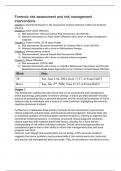Samenvatting
Samenvatting - Capita Selecta Forensic Risk Assessment
Dit is een samenvatting van de gehele stof voor het vak Capita Selecta: Forensic risk assessment and risk management interventions, met uitzondering van de voorbeeld cases.
[Meer zien]





